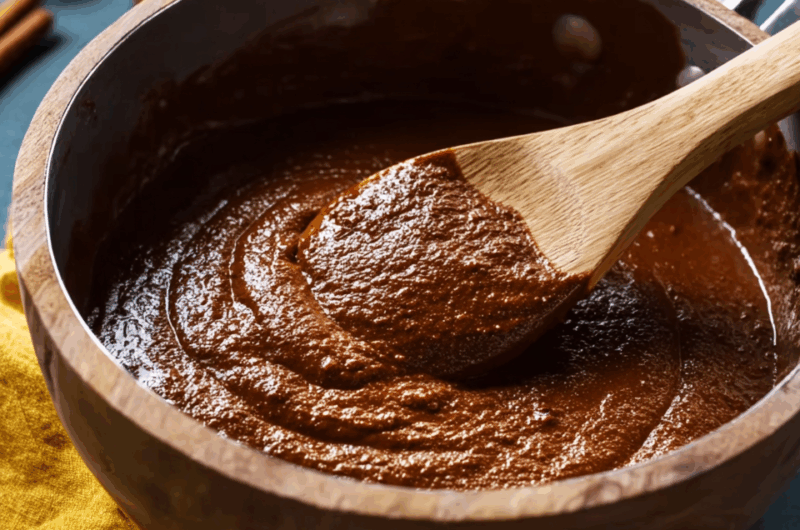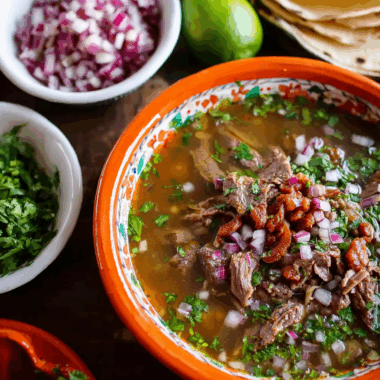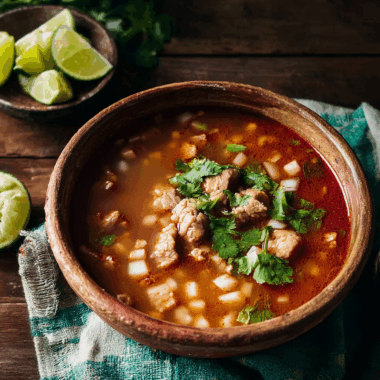This authentic mole sauce combines a blend of smoky, sweet, and spicy ingredients that result in a deep and rich flavor profile. The combination of dried chilies, dark chocolate, and a variety of seeds and nuts makes for an incredibly complex sauce that elevates any dish it touches.
Perfect for pairing with roasted chicken, grilled pork, or even over enchiladas, this mole is a Mexican classic that’s as versatile as it is delicious. Whether served as a topping, a dip, or a stew base, it provides that warm, comforting touch that makes everything taste better. Once you try it, you’ll find it hard to go back to store-bought sauces!
Full Recipe:
-
2 dried pasilla peppers
-
2 dried mulato peppers
-
2 dried ancho peppers
-
1 tablespoon sesame seeds
-
1 tablespoon cumin seeds
-
1 tablespoon coriander seeds
-
1 tablespoon black peppercorns
-
1/4 cup almonds
-
1/4 cup sunflower seeds
-
1/4 cup raisins
-
1/2 cup dark chocolate, chopped
-
1 medium onion, chopped
-
2 cloves garlic, minced
-
2 cups chicken broth
-
1/4 cup vegetable oil
-
1 tablespoon tomato paste
-
1 tablespoon sugar
-
Salt to taste
Directions:
-
Begin by removing the stems and seeds from the dried peppers. Toast them lightly on a dry skillet over medium heat until fragrant, about 1-2 minutes. Transfer them to a bowl and cover with hot water. Let them soak for 20 minutes to soften.
-
While the peppers are soaking, toast the sesame seeds, cumin, coriander, and black peppercorns in the skillet until fragrant. Grind the spices in a spice grinder or mortar and pestle until finely powdered.
-
In the same skillet, toast the almonds, sunflower seeds, and raisins for about 3-4 minutes until lightly browned and fragrant.
-
In a blender, combine the soaked peppers, toasted spices, almonds, sunflower seeds, raisins, dark chocolate, onion, garlic, and chicken broth. Blend until smooth.
-
Heat vegetable oil in a saucepan over medium heat. Add the mole mixture and cook, stirring often, for about 10-15 minutes. Stir in the tomato paste, sugar, and salt, and continue to cook until the mole thickens to a sauce consistency.
-
Serve over chicken, pork, or enchiladas, or use it as a base for soups or stews.
Prep Time: 25 minutes | Cooking Time: 30 minutes | Total Time: 55 minutes
Kcal: 85 kcal (per 1/4 cup serving) | Servings: 8 servings
The Rich History of Mole Sauce
Mole is much more than just a sauce in Mexican cuisine; it’s a tradition, a history, and a deep connection to the culture. It is one of Mexico’s most iconic and beloved dishes, known for its complex flavors and versatility. Mole has been a part of Mexican culinary history for centuries, with various regions offering their own versions and variations. The word “mole” comes from the Nahuatl word “molli,” which means “sauce” or “concoction.”
There are many different types of mole, but perhaps the most famous is Mole Poblano. This version is a rich, velvety sauce that includes ingredients like dried chilies, nuts, seeds, chocolate, and spices. The complex blend of flavors results in a deep, savory sauce with both sweet and spicy elements.
The Key Ingredients That Make Mole Sauce Special
Mole sauce is a perfect blend of several contrasting ingredients, each playing an essential role in its flavor profile. The primary components—dried chilies, chocolate, and seeds—create a harmonious balance of heat, sweetness, and nuttiness that defines the sauce.
The dried chilies, often pasilla, ancho, and mulato, provide a smoky, earthy base. These chilies are roasted to bring out their natural flavors and soften their bitterness, giving mole its distinctive depth. The addition of dark chocolate adds richness and a subtle sweetness, a characteristic that sets mole apart from other spicy sauces.
Nuts and seeds, such as sesame seeds, almonds, and sunflower seeds, give mole a smooth, velvety texture. They also contribute a mild, nutty flavor that complements the heat from the chilies. Meanwhile, raisins provide a hint of natural sweetness, balancing out the heat and bitterness of the chilies.
How Mole Sauce is Traditionally Served
Mole is a versatile sauce that can be paired with a wide range of dishes. Traditionally, it is used as a topping for roasted or braised meats, such as chicken, turkey, or pork. One of the most iconic mole dishes is mole poblano served over chicken. The rich, spiced sauce perfectly complements the tender meat, creating a satisfying and hearty meal.
Mole is also a key ingredient in enchiladas, tacos, and tamales, where it adds a deep, savory flavor to these classic Mexican dishes. For an even more festive presentation, mole can be drizzled over a bed of rice or served with tortillas for dipping.
In addition to its use in main dishes, mole can also be the base for soups and stews, where its intense flavor imparts a satisfying richness to the broth.
Why You Should Try Making Authentic Mole Sauce at Home
While you can find bottled mole sauce at the store, there’s something undeniably special about making mole from scratch. Making mole sauce at home allows you to control the balance of flavors and tailor it to your preferences. It’s an opportunity to embrace the tradition of mole-making while experimenting with different spices and chili varieties.
One of the biggest advantages of homemade mole is that it allows you to incorporate fresher, higher-quality ingredients. The depth of flavor achieved by slowly toasting spices, nuts, and seeds cannot be replicated in a store-bought version. Furthermore, homemade mole doesn’t have the preservatives or artificial additives that you might find in pre-made sauces, making it a cleaner, more authentic option.
Though making mole might seem intimidating at first, the process is actually quite rewarding. With a little patience and the right ingredients, you can create a mole sauce that will rival even the best restaurants, bringing the authentic taste of Mexican cuisine to your own kitchen.
Mole Sauce Variations Across Mexico
As mentioned, mole has many variations across Mexico, each region adding its own twist to the sauce. The mole poblano, with its combination of chilies, chocolate, and spices, is one of the most famous, but it’s far from the only version.
In Oaxaca, for example, mole negro is a popular variety made with a blend of seven different types of chilies and dark chocolate. It is known for its intense flavor and deep black color. Mole verde, which uses ingredients like tomatillos, cilantro, and green chilies, provides a more tangy and herbal flavor compared to the rich, dark mole poblano.
Other variations include mole rojo, which is lighter in color and slightly spicier, and mole amarillo, which is made with yellow chilies and often features turmeric for a more vibrant color. Each version has its own unique flavor profile, but all share the same basic principle of combining chilies, seeds, nuts, and chocolate to create a sauce that is both complex and comforting.
The Complexity and Beauty of Mole Sauce
The complexity of mole sauce is one of the things that makes it so beloved by those who enjoy cooking and eating it. The layers of flavor—smoky, spicy, sweet, and savory—come together to create a sauce that is truly unique. Making mole is not a rushed process; it requires time and patience to bring out the best in each ingredient.
One of the most rewarding aspects of mole is that it improves with time. Like many stews and sauces, mole develops even deeper flavors after it’s been stored for a day or two. This makes mole a great make-ahead dish that can be prepared in advance for a special meal or family gathering.
Pairing Mole with Wine and Other Drinks
Mole is a rich, flavorful sauce that pairs well with a variety of beverages. Because of its bold flavors, it’s best complemented by drinks that can stand up to its intensity.
A bold red wine, such as a Zinfandel or Merlot, works wonderfully with mole dishes, especially those that feature chicken or pork. The wine’s fruity notes balance the heat from the chilies and the richness of the sauce.
If you prefer beer, try pairing mole with a malty amber beer or a dark stout. The maltiness of the beer complements the deep, roasted flavors of the mole, while the carbonation helps cleanse the palate between bites.
For a non-alcoholic option, try a refreshing glass of iced hibiscus tea or agua fresca. The tanginess of the hibiscus or the sweetness of a fruit-based agua fresca offers a nice contrast to the richness of the mole sauce.
How to Store Mole Sauce and Extend Its Shelf Life
Mole sauce can be made in large batches and stored for later use, which is one of the reasons it’s so popular in Mexican homes. After preparing the mole, let it cool to room temperature, then store it in an airtight container in the refrigerator. It can last for up to a week when properly stored.
If you’d like to store it for even longer, mole can be frozen. Simply portion the mole into freezer-safe bags or containers and store it in the freezer for up to three months. To use frozen mole, let it thaw overnight in the refrigerator and then reheat it on the stove.
Conclusion: The Timeless Appeal of Mole Sauce
Mole sauce is more than just a recipe; it’s a cultural treasure that brings together the flavors of Mexico’s diverse regions and traditions. Its complexity and depth of flavor make it a dish worth mastering in your kitchen, whether you’re preparing a comforting weeknight meal or celebrating a special occasion. With its versatility and rich history, mole continues to be a dish that brings people together around the table, offering a taste of Mexico’s vibrant culinary heritage. Whether served over chicken, pork, or vegetables, mole adds an unforgettable layer of flavor that will make any dish extraordinary.
Creating mole sauce from scratch may take time, but the result is a deeply satisfying, flavorful sauce that will elevate any dish. So, whether you’re new to mole or a seasoned pro, don’t be afraid to explore the world of mole sauce—your taste buds will thank you!








